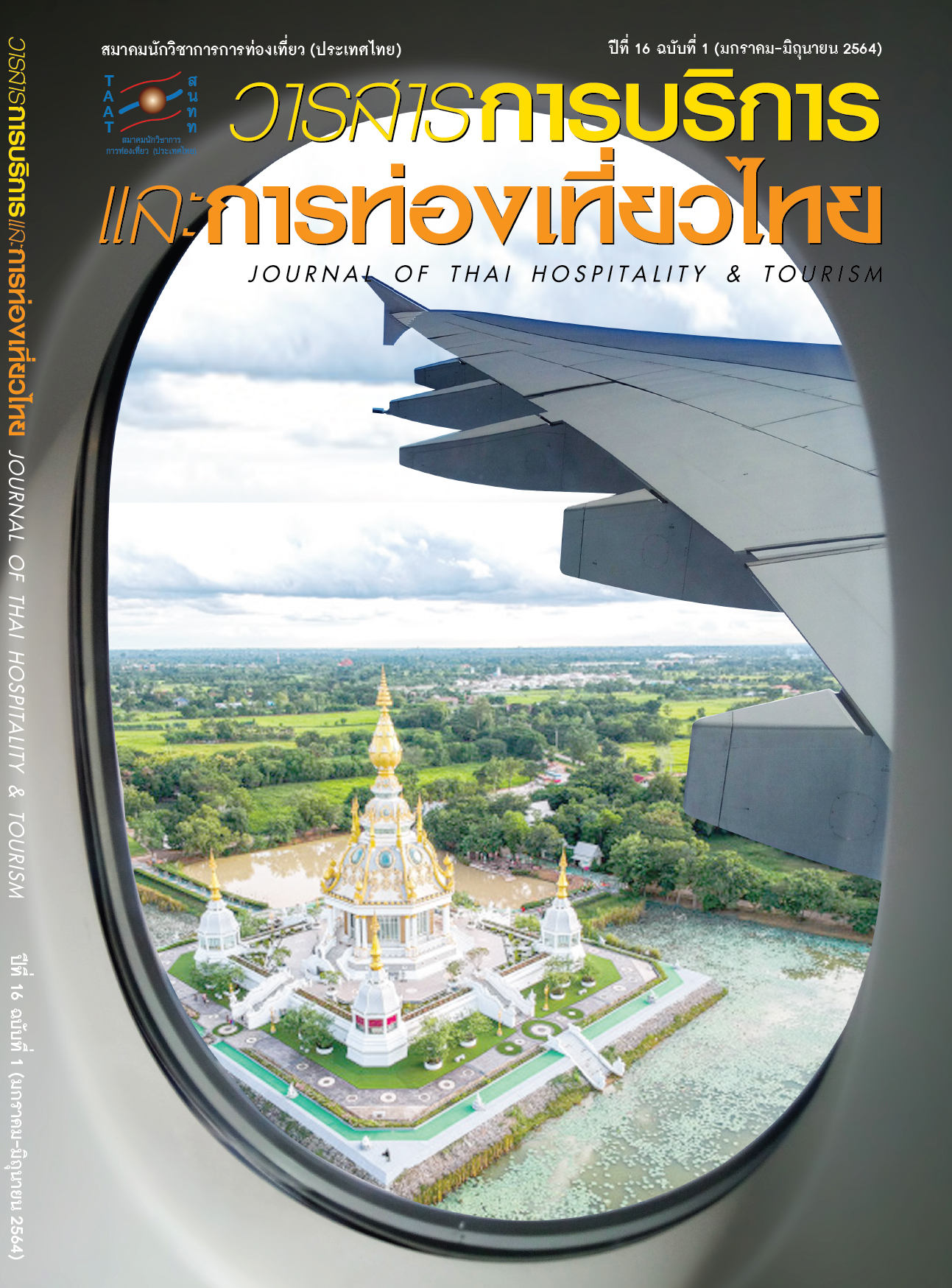The Causal Model of Slow Travel Intention with Behavior as a Mediating Variable
Main Article Content
Abstract
The purposes of this research was to study factors influencing slow tourism behavior of slow tourists. They were motivation and awareness of slow destination’s readiness with travel behavior as a mediating variable. Four hundred and forty samples were collected through questionnaires at four slow tourism destinations. The factors included slow tourism motivation, slow tourism perception, slow tourism tourist behavior and slow tourism intention of revisiting. Most were female in age 20-30 with a monthly income between 10,001 – 20,000 Baht. The analysis of slow tourism behavior showed that Thai slow tourists spent the longest travel period of 8 days and the shortest period was a 1-day trip. Local tourists traveled 7 times to slow tourism sites within 2 years with the highest travel budget of about 15,000 Baht. The structural model showed that slow tourism motivation factors had a strong relationship with slow tourist behavior at the significant level of 0.05. Slow tourism perception had no influence on slow tourism behavior and slow tourism behavior had no influence on revisiting intention of Thai tourists.
Article Details
References
Chanin Yoopetch. (2012). Fast Growth of Slow Tourism. Tourism and Hospitality Management Quarterly Review, 5, 5–6.
Chantouch Wannathanom. (2009). Planning and Travel Agent. Bangkok: Warat Education Press.
Chuchai Smithikrai. (2018). Consumer Behavior. Bangkok: Chulapress.
Cittaslow. (2016). Network. Retrieved from http://www.cittaslow.org
Dickinson, J. E. & Lumsdon, L. M. (2010). Slow Travel and Tourism. Earthscan.
Gardner, N. (2009). A Manifesto for Slow Travel. Hidden Europe Magazine, 25, 10–14.
Harvey, D. (1989). The Condition of Postmodernity. Oxford: Blackwell.
Heitmann, S., Robinson, P. & Povey, G. (2011). Slow Food, Slow Cities and Slow Tourism. In Robinson, P., Heitmann, S. & Dieke, P. (Eds.), Research Themes for Tourism (pp. 14–127). United Kingdom: CAB International.
Hubbard, P. & Lilley, K. (2002). Pacemaking the Modern City: the Urban Politics of Speed and Slowness. Environment and Planning D: Society and Space, 22(2), 273–294.
Kanyala Swangkong. (2015). An Assessment of Potential’s Tourist Attraction towards Tourist’s Perspective: A Case Study of Waterfall’s Tourist Area in Saraburi Province. Journal of Social Sciences Srinakharinwirot University, 18, 18–25.
Manager Online. (2010). My Slow Day. Retrieved from http://www.mgronline.com
Miele, M. (2008). Cittaslow: Producing Slowness against the Fast Life. Space and Policy, 12(1), 135–156.
Ministry of Tourism & Sports. (2016). Tourism Statistics. Retrieved from http://www.mots.go.th/
more_news_new.php?cid=435
Ranee Esichaikul & Chatchapol Songsonthonwong. (2012). Slow Tourism: Learning through Interpretation for European Senior Tourists. Journal of Thai Hospitality & Tourism, 7(1), 41–57.
Siwarit Pongsakornrungsilp. (2012). Principles of Marketing. Bangkok: Top Publishing.
Slow Travel. (2014). What is Slow Travel? Retrieved from http://www.slowtrav.com
Suree Boonyanupong & Korawan Sangkakorn. (2012). Slow Tourism Management for Elderly Tourists in Upper Northern. MBA–KKU Journal, 5(1), 58–100.
Tourism Authority of Thailand News. (2009). Amazing Thailand. Retrieved from http://www.tatnewsthai.org
Tourism Authority of Thailand. (2006). Tourism Industry. Bangkok: Tourism Authority of Thailand.
Verilio, P. (1986). Speed and Politics. New York: Semiotext.
Witawat Rungruangphon. (2012). Prince of Marketing. 7th ed. Bangkok: Thammasat University Press.
World Tourism Organization. (2015). UNWTO Annual Report 2014. Madrid.
Wuttichai Kritsanaprakornkit. (2015). Slow Travel. Retrieved from http://www.etatjournal.com/web/
menu-read-taat/menu-2015/menu-42015/684-42015-slow-travel-trend


